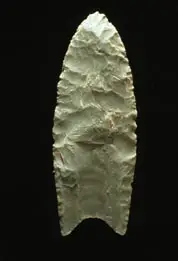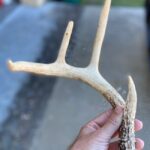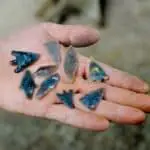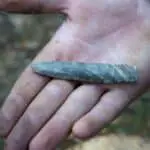The most expensive arrowhead ever sold was a prehistoric Clovis point, made of rare green obsidian that went for a whopping $276,000!
The most sought-after and rare arrowheads are Clovis points made from a unique material. Clovis points are prehistoric tools native to North America that are roughly 10,000 to 13,500 years old. It is said that there are only about 10,000 Clovis points ever found, making them the rarest arrowheads in the world.
This page contains affiliate links. As an Amazon Associate, I earn from qualifying purchases.
Table of Contents
- What are Clovis Points?
- Why are Clovis Points so Rare?
- Are Clovis Arrowheads the Oldest Types of Arrowheads?
- Why are Clovis Points Worth More than Other Ordinary Arrowheads?
- Where can You Find Clovis Points?
- Other Rare Types of Arrowheads
- Conclusion
What are Clovis Points?

Clovis points are known as a type of prehistoric tool made by natives in North America roughly 10,000 to 13,500 years ago. Clovis Points are made from specific rocks, including chert, jasper, obsidian, quartzite, and chalcedony, that break in predictable ways when hit with a harder object to create a smooth, sharp edge.
Clovis points were made using what archeologists formerly thought was the oldest form of technology. However, later on, pre-Clovis tools that existed beforehand were discovered and confirmed to be older than Clovis points.
Regardless, Clovis points are still the most famous prehistoric points in the Americas.
Clovis points are named after their discovery site in the town of Clovis in New Mexico in 1932. Even though Clovis points are often referred to as Clovis arrowheads, most Clovis points are actually spearheads known as projectile points.
What does a Clovis Point Look like?
Clovis points have a distinctive appearance that makes them relatively easy to recognize.
Apart from being easy stones to work with, they are often beautiful materials found in a variety of colors.
However, their most distinguishable feature of Clovis points is their flute– a small groove of roughly one inch long made near the base of the tool to easily attach their arrowheads to a shaft without cutting the user.
Most Clovis points were used as darts for spear-throwers. Spear-throwers were most commonly used before bows and arrows were available.
Clovis arrowheads have similar characteristics to Folsom or Dalton arrowheads, so it can be tricky to distinguish them from a non-expert collector.
Here are a couple of identifying characteristics that will make them easier to distinguish:

- Clovis arrowheads are generally larger than Folsom and Dalton point types.
- Clovis arrowheads are large and fluted (grooved), and their flutes are extended from the base up to about half of the entire point.
- Clovis arrowheads are approximately 1 to 6 inches tall and 1 to 2 inches wide.
- Clovis arrowheads have a slender and concave base and convex or parallel curved sides, meaning that the points are widest in the middle of the arrowhead and narrower towards the bottom where the arrowhead is connected to the shaft.
- The broadest areas of Clovis arrowheads are situated in the midsection or toward the point of the arrowhead.
- Clovis arrowheads are primarily crafted out of chert or more common stones.
Why are Clovis Points so Rare?
Clovis points are prehistoric arrowheads making them much harder to find than other arrowheads made only a couple of centuries ago. There are only approximately 10,000 Clovis points, making them an extremely rare find.
Clovis arrowheads are one of the oldest stones projectile point types.
Are Clovis Arrowheads the Oldest Types of Arrowheads?
While Clovis arrowheads are the most valuable points you can come across, they are not the oldest.
Clovis arrowheads range between 12,000 to 13,000 years old. At the same time, a number of “pre-Clovis” sites have been discovered with tools, possibly up to 24,000 years old.
Why are Clovis Points Worth More than Other Ordinary Arrowheads?
Arrowheads are relatively common and easy to find. You won’t be able to sell a typical arrowhead for a lot of money. While most arrowheads aren’t worth much, some of them are worth a fortune.
Clovis points are worth more due to their rarity. While other arrowheads made in recent centuries are easy to find, Clovis arrowheads are much harder to come across. Therefore, when found, they can sell hundreds or thousands of dollars.
Another reason as to why Clovis points are worth so much more is that they disappeared relatively early in American prehistory, being replaced by Folsom and Dalton points. Lastly, Clovis points may have only ever existed in North America and South America.
Where can You Find Clovis Points?
Clovis points can be found all over North America and in some areas in South America; however, they have not been found any farther south than Venezuela.
As they are currently named after Clovis, New Mexico remains one the most popular places to find Clovis points.
Other Rare Types of Arrowheads
Although not as rare as Clovis points, there are dozens of other rare and valuable types of prehistoric arrowheads sought after. Let’s look at a few:
1. Folsom Points
Folsom points originated somewhat later than Clovis points; it is said that Folsom points may have replaced Clovis points.
Folsom points have wide grooves along their edges and are fluted, similar to Clovis points, however, with a better fluting technique than Clovis points.
Like Clovis points, Folsom points are also worth up to hundreds and thousands of dollars. Large Folsom points found in New Mexico are currently worth not much less than $4000.
2. Dalton Points
Dalton points were used from 10500 BC to 8500 BC and are also said to have been a replacement for Clovis points. Dalton points were used for a relatively long period.
Dalton points are often fish-shaped; they curve inward near the base of the point and outward again near the bottom of the arrowhead. In addition, Dalton points have an outward curve in the middle, giving them their distinct shape.
3. Plano Points
Plano points are later prehistoric points used in great plain regions. Plano points are not fluted like Clovis points, and flaking was used to create its edges.
Many of the Plano arrow points seemed too fragile to have been effective.
See Also: Are Arrowheads Worth Money?
Conclusion
Many prehistoric and rare arrowheads are worth a fortune; however, nothing comes close to a large Clovis arrowhead! Clovis arrowhead is by far the rarest arrowhead worldwide, with only about 10,000 of them ever found.
These rare arrowheads are worth a fortune, ranging from hundreds to thousands of dollars!
If you want to know how much your arrowheads may be worth, check out The Official Overstreet Indian Arrowhead Identification and Price Guide Book.
And If you ever find an arrowhead that seems to be prehistoric, do take the time to correctly identify it and find out what it’s worth before hastily selling it to someone that might rip you off with a smile.






